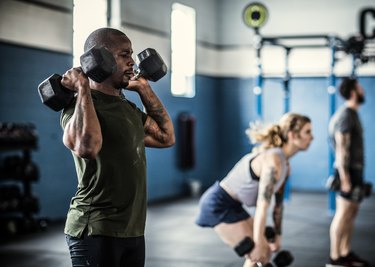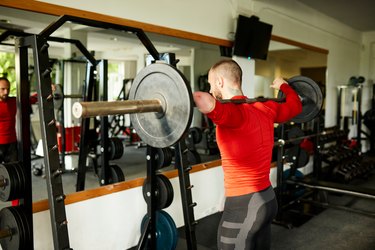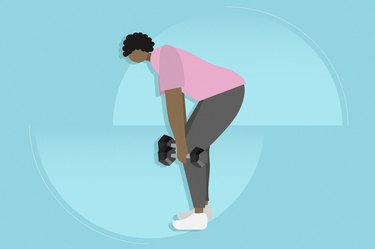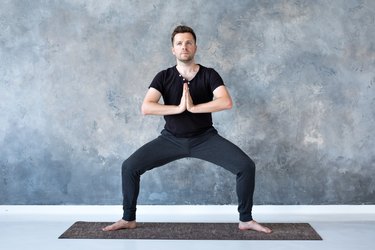

Dumbbell squats are the Swiss Army knife of leg day. There are so many ways to do them (we'll show you how to do seven here). And while they're perfect for people just graduating from air squats, no matter how advanced you might be, you never outgrow a good DB squat. Never.
- What is a dumbbell squat? It's a lower-body exercise that involves holding one or two dumbbells and bending your hips and knees to lower as far as comfortable, then standing back up.
- Is squatting with dumbbells effective? Yes! Dumbbell squats are an effective way to progress your lower-body workouts, build muscle and get your heart rate up.
- What muscles do dumbbell squats work? They strengthen your glutes, quads, hamstrings and calves. But as you work to keep a neutral torso with good posture, you also train your core muscles. Certain variations also work your shoulders, lats and forearms.
- Who can do the DB squat? Almost everyone can do this exercise in some form. If you have a previous knee injury or back issues, speak to your doctor or a physical therapist before you incorporate this move into your routine.
Video of the Day
How to Do a Dumbbell Squat With Perfect Form
- Stand with your feet about shoulder-width apart. You can turn your toes slightly out or point them straight ahead. Hold dumbbells at your sides, palms facing in.
- Fill your chest with air to set your core. Maintain a tight, vertical torso throughout the movement with a natural arch in your low back.
- Push your hips back and bend your knees to lower down until your thighs are parallel to the floor. Keep your chest up and your weight in your heels.
- Push your feet into the ground to stand back up.
Watch the Full Tutorial
How Much Weight Should I Squat With Dumbbells?
Use a weight that challenges you, just allowing you to eek out your last reps with proper dumbbell squat form: Keep your chest proud, your back slightly upright and your weight in your heels. Your knees should not cave in or bow out as you lower and stand back up.
6 More of the Best Dumbbell Squat Variations
Sure, maybe you could call the traditional arms-at-your-sides version, the one, true "DB squat." But, in reality, there are many ways to squat with dumbbells. Try these DB squat variations, progressing from the most accessible to most difficult.
Move 1: DB Goblet Squat
Only have one dumbbell? That's all you need for this move. And besides being super accessible for at-home workouts, it's also a really comfortable variation for mastering form before progressing to heavier lifts.
- Stand with your feet about shoulder-width apart. Hold a dumbbell in front of your chest vertically. Your hands should cup the head of a dumbbell — like you’re holding a goblet. Brace your core.
- Push your hips back and bend your knees to lower down as far as comfortable. Keep your chest up and your weight in your heels. Keep a straight, largely vertical torso.
- Press through your feet to stand back up.
Move 2: DB Hack Squat
Also called an heels-elevated squat, this variation helps you squat deeper by boosting your heels an inch or two off of the floor. Raised heels, like you'll get with the best weightlifting shoes, increase your ankle mobility so you can lower down more comfortably and easily.
- Stand with your feet about shoulder-width apart and set your heels on small weight plates (around 2.5-pound plates). Hold the dumbbells at your sides, palms facing in. Brace your core.
- Push your hips back and bend your knees to lower down as far as comfortable. Keep your chest up and your weight in your heels. Keep a straight, largely vertical torso.
- Press through your feet to stand back up.
Move 3: DB Sumo Squat
Sumo squats work your inner thighs and side glutes harder than most variations. Play around with your stance and pay attention to how those muscles feel.
- Stand with your feet about twice the width of your shoulders, toes turned slightly out. Hold a dumbbell between your legs at arm’s length and let it hang. Brace your core.
- Push your hips back and bend your knees to lower down as far as comfortable. Keep your chest up and your weight in your heels. Keep a straight, largely vertical torso.
- Press through your feet to stand back up.
Move 4: DB Front Squat
You might also hear this called a rack squat because it involves holding the weights in a "rack" position in front of your shoulders. Whatever you call it, it shifts some of the exercise's focus to the quads and knees from the glutes and hips. It also engages your delts and shoulder stabilizers.
- Stand with your feet about shoulder-width apart. Lift the dumbbells up so that one head of each dumbbell rests on your shoulder, palms facing in. Brace your core.
- Push your hips back and bend your knees to lower down as far as comfortable. Keep your chest up and your weight in your heels. Keep a straight, largely vertical torso.
- Press through your feet to stand back up.
What About Dumbbell Back Squats?
We don't recommend doing back squats with dumbbells. Getting the weight into position puts a lot of stress on your shoulder joints and tends to force the middle and lower back to arching, causing pain and risking injury.
Move 5: DB Split Squat
Unilateral, single-side squats, help you zero in on one leg at a time while building balance, stability and extra core strength. Start with this version. If it feels too challenging, practice it without the DB.
- Stand with your feet shoulder-width apart and hold the dumbbells at your sides, palms facing in. Take a large lunge step forward with your right leg so that your right leg is 2 to 3 feet in front of your left. Your front foot should be flat, and your back toes tucked. Brace your core.
- Keeping your torso upright, push your hips back and bend your front knee to lower down as far as comfortable.
- Press through your feet to stand back up.
Move 6: DB Bulgarian Split Squat
Once you've mastered DB split squats with both feet on the floor, try elevating your back one on a step or bench. This forces your front leg to work even harder. The higher your back foot is raised, the harder the exercise gets. So if you're having trouble, use a lower bench or step.
- Hold the dumbbells at your sides, palms facing in. Place one foot behind you on a bench or chair and the other foot in front of you in a lunge position, so your leg forms a 90-degree angle. Brace your core.
- Keeping your torso upright, push your hips back and bend your front knee to lower down as far as comfortable.
- Press through your feet to stand back up.
- Do all reps, then switch sides.
The 3 Best Dumbbell Squat Tips
If you hold the weights by your side, in front of you, whatever — hitting these DB squat form tips will help you get the greatest benefits from every rep and set.
1. Keep Your Weight in Your Heels
If your heels lift up from the ground with each rep, try a different foot placement or do some sets with small weight plates under your heels. By elevating your squats, it helps take the load off tight calves, which may be keeping your knees from moving past your toes without lifting your heels.
Or try squatting barefoot so you can grip the floor with your entire foot and think about pushing the floor away from your feet. This gives you better contact with the ground so you can activate your glutes and quads and get lower.
Related Reading
2. Form a Straight Line from Head to Hips
It's tempting to gaze at the ceiling to keep your chest up and open, but this can cause back or neck pain. Keep your neck aligned with the rest of your spine by looking straight ahead or slightly down — at about a 20-degree angle— to avoid compressing your neck and lumbar spine.
3. Keep Yours Shins and Back Parallel
If you're squatting next to a mirror or have a phone handy for recording, take a quick peek to your side to see your squat from the side. At the bottom of your squat, your shins and back should be roughly parallel. This ensures you're keeping an upright torso and keeping your weight in your heels.
Pro tip: If your shins and back are anything but parallel, focus on bending and straightening your hips and knees at the same time and speed with each rep.
5 Benefits of Dumbbell Squats
No matter the variation, you can expect the following benefits.
1. They Work Your Entire Body
Depending on where you hold the weights (by your chest in a goblet position, in front of your shoulders or at your sides), different variations can recruit multiple muscle groups at once.
For example, a goblet squat activates your shoulders and core to keep your chest lifted and your back upright. A split squat targets the muscles in each leg, ensuring you're building equal strength on both sides, while enlisting the muscles in your forearms and back to keep the weights by your sides.
2. They Can Reduce Knee Pain
Squats strengthen your glutes, hips and quads, which all play a large role in stabilizing your knee joint and preventing pain. When you strengthen these muscles, they're able to carry a majority of the load and absorb ground forces so your knees don't have to compensate.
For people living with knee osteoarthritis, doing lower-body strength exercises like squats three times a week can reduce knee pain by 43 percent, according to a July 2001 study in the Journal of Rheumatology.
And using dumbbells versus barbells may be the way to go if you live with osteoarthritis. A February 2021 study in JAMA found that doing lower-intensity leg exercises, such as DB squats, is more effective for alleviating knee pain than higher-intensity moves.
3. They Can Improve Your Squat Depth
Because the exercise uses lighter weights, you can often squat lower with DBs than you can with a barbell. This is especially true if you're doing a goblet squat, which involves holding the weight in front of your chest.
And you want to be able to get low because it builds more muscle. In fact, an April 2012 review in the Journal of Strength and Conditioning Research found that squatting with parallel depth (meaning your thighs end up parallel to the floor) works the glutes the hardest.
4. You Can Do them Anywhere
Not every gym has a squat rack and not everyone has room in their home for barbells. One of the best dumbbell squats benefits is that they let you strengthen your glutes and quads anywhere, even in the tiniest of spaces.
5. They're Great for HIIT Workouts
This lower-body move is ideal for circuit training — doing a series of exercises in sequence — because you can easily use the weights to do the next move without having to stop. For example, you can do a DB squat then go straight into a bent-over dumbbell row or shoulder press.
- Journal of Rheumatology: "The Efficacy of Home Based Progressive Strength Training in Older Adults with Knee Osteoarthritis: A Randomized Controlled Trial"
- JAMA: "Effect of High-Intensity Strength Training on Knee Pain and Knee Joint Compressive Forces Among Adults With Knee Osteoarthritis"
- Journal of Strength and Conditioning Research: "Muscle Activation in the Loaded Free Barbell Squat"


